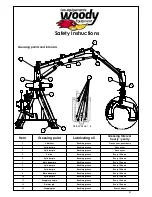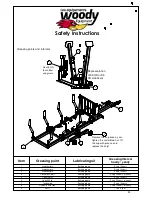
Safety Instructions
If the overload protection of the hydraulic system is not properly adjusted or certain system
functions are altered, safety cannot be ensured.
.
Always lower the hydraulic stabilizers before each operation to avoid overturning.
.
Always check that any unauthorized personnel remains outside the work risk area.
. Never stand under a suspended load.
. Make sure that the tractor and trailer are always on firm ground so that there is no risk of overturning.
When loading, use the stabilizers to prevent tilting of the loader
.
.
Make sure you always have a visual view of the work area.
. Do not work in conditions where you may get your fingers caught or hurt yourself
.
When there is a risk of overturning, immediately lower the stick boom with the control lever.
.
Hold the lever in this position until the load is on the ground. Do not interrupt the lowering movement as the risk of
overturning will increase if the load stops abruptly.
. If the tractor rolls over, follow the instructions in the cab. Do not jump out of the cab. You could end up
under the load during a fall or under the tractor
.
Note: Even if the stabilizers have been lowered to the ground, the risk of overturning is greater when the trailer is
empty or partially loaded.
Cracks in hydraulic hoses
. In the event of pressure loss in the hydraulic fluid or cracks in the hydraulic hoses, you must immediately
shut down the tractor engine and lower the load to the ground. Stop the hydraulic flow. Repair the leak.
. If the main pressure hose between the tractor and the control system is cracked, you must interrupt the
oil flow by disconnecting the lever control associated with the tractor's hydraulic distributor or by shutting
off the engine with the OFF button.
17
























